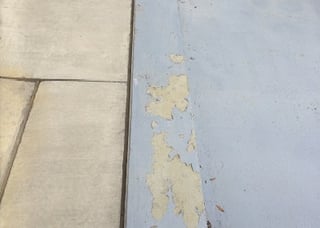 There’s nothing more frustrating than taking time out of your production schedule to have a new floor coating installed, only to have it peel or crack just months (or days!) later. What causes new floor coatings to fail?
There’s nothing more frustrating than taking time out of your production schedule to have a new floor coating installed, only to have it peel or crack just months (or days!) later. What causes new floor coatings to fail?
Here are some of the most common causes for floor coating peeling, bubbling and more:
Oil residues
Does your facility regularly uses oils, greases or corrosive substances? If these have ever been spilled on your floor, they may have soaked into the concrete at some point (after all, concrete is a porous material).
If your floor was properly prepared and received the proper inhibitive coatings before the new floor coating was installed, these residues should have been taken care of. But if they weren’t, the oils could be reacting with the coating, causing it to crack, blister, and peel.
Old floor coatings
Before installing a new coating, the old coating may need to be completely removed. The new coating system is designed to bond with the concrete itself or with similar coatings, but there is no guarantee it will properly bond to another type of coating. It's important to get a proper evaluation first to determine whether you need surface preparation to the existing coating. You may also need a sample test installation first.
In addition, existing coatings that are not properly abraded (or properly cleaned before and after abrading) may result in isolated or total coating failure.
Unresolved moisture issues
If you’re noticing blisters or “fisheyes” in your floor coating, there’s a good chance that unregulated moisture could be the culprit. There are a couple of potential causes for concrete moisture, including water vapor from the ground seeping up through the porous concrete.
To determine whether moisture is the cause of your floor coating failure, you’ll want to have a professional moisture test done.
Improper installation conditions
Some coatings require specific temperatures during application, or must be maintained at a certain humidity level during the curing process. Other coatings will dry evenly only when they are applied in thin layers and may need to dry completely before a second coat is added.
Your coating installer should have been aware of these conditions and of the "recoat windows" of the products used, but if they were in a rush or weren’t careful to keep the environment stable, they may have set the floor coating up for failure.
What to do now
If the blistering or peeling is limited to minor areas, it may be possible to fix just the troublesome spots. In more extreme cases, the whole coating may need to be stripped and re-applied.
In either case, you’ll want to determine the actual cause of the problem first, or you may run into the exact same issues the second time around.
If you’d like a second opinion and live in the Southeastern U.S., give CPC Floor Coatings a call at (864) 855-0600. We’d be happy to help you figure out the causes of the problem and to recommend solutions.

